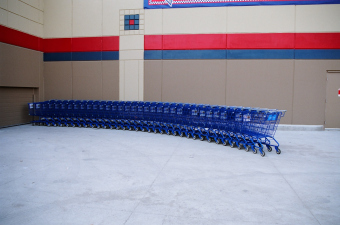Working For Wal-Mart, Part One
By Kevin Robinson in News on Mar 10, 2010 6:20PM
As part of our on-going coverage of Wal-Mart’s attempt to break into the Chicago retail market, we take a look this week at the company’s employment practices in the Chicago metropolitan area. Chicagoist met up with three Wal-Mart employees to talk to them about their jobs, company policy, and why they work there.
A key point in the debate over whether Wal-Mart should be allowed to expand into Chicago is the issue of jobs. For Wal-Mart boosters in Chicago, bringing jobs into underserved, largely African American communities has been front and center in making the case for the mega-retailer's expansion into the city. There’s little question that the need for jobs is critical to the future of Chicago, especially in African-American communities. While the unemployment rate both in Chicago and nationally hovers at around 10 percent, African-Americans disproportionally suffer from unemployment at a higher rate. According to the Bureau of Labor Statistics, the 2009 annual average unemployment rate among African-Americans in Illinois is just over 17 percent. Reliable statistics on the percentage of black employees in Wal-Mart stores are hard to come by; numbers range from over 12 percent in management, to 15 percent in among company truck drivers, to 17 nationally. Regardless of how you break the numbers out, it's a fair bet that Wal-Mart will hire within the community, meaning that the majority of jobs in their proposed Chicago stores will be filled by African-Americans.
While there’s little dispute that jobs are critical in African-Americans neighborhoods in Chicago, absent from the discussion are the voices of the workers that hold some of the jobs Wal-Mart is proposing for Chicago. I met up with three local Wal-Mart employees - Rosetta Brown, an African-American who’s worked for Wal-Mart for 12 years, Roslyn Landfair, also African-American, a five-year employee who was fired from her job as a cashier at last year after injuring her arm in a turnstile, and Linda Haluska, who is white and has worked for Wal-Mart for four years - to talk about what working at the big box is like.
Wal-Mart operates their stores to get maximum work out of the minimum number of employees they can. Linda Haluska, who works at the company’s Glendale store, stocks the Health and Beauty Aids (HBA) section on the overnight shift. “On a nightly basis, when a truck gets in, I might have three pallets of cosmetic items to stock, which is about 50 boxes. That’s quite a bit for one person.” HBA is four aisles, and there are two aisles of cosmetics, each about 40 feet long. The pallets come in loaded with boxes of small items. “One aisle may have between 300 - 500 individual products: mouthwash, deodorant, toothpaste, bath and body wash, pads. And that’s just one department.”
Linda stocks the department by herself for several reasons. She’s been outspoken for her support of forming a union at Wal-Mart, which means that managers make an effort to keep her isolated from other employees. But reducing the number of employees that stock a section is part of the company’s business strategy. “When I started out in Infants,” Rosetta tells me, “the first day I started [at Wal-Mart], it was five of us. Each month they took one person away, and it just left me. And they still expected me to do what five of us was doing.” Linda nods in agreement. “They would come and get me to come and unload the truck, and expect me to come and finish the work.”
Rosetta found the same situation when she transferred to Sam’s Club, which is owned by Wal-Mart. “I got there the first night and I had to lift 50 pounds. They put me in the section called hard-lines, and that's what it was, hard. Aluminum foil, soda in bulk, everything sold in bulk, garbage bags, heavy as, I thought ‘What did I get into?’” Linda agrees. “When you apply at Wal-Mart, on the application they do say you have to be able to lift at least up to 50 pounds. But a lot of times there’s more than 50 pounds. And a team lift [when you get someone else to help lift heavy items] is not always available.”
Rosetta learned the hard way there can be consequences to those physical requirements of work at Wal-Mart. While she now works at the Sam’s Club in Cicero as a greeter, that wasn’t always her job. In 1999, she was helping to unload pallets from a truck on the midnight shift at the store. The pallet jack was broken - the fork was bent - and when she tried to pull it out from under the loaded pallet, she herniated a disc in her back. Labor injuries aren’t uncommon in the grocery industry. A 2003 study of on-the-job injuries in the grocery industry conducted by the Bureau of Labor Statistics found that sprains and strains accounted for 45 percent of injuries, 35 percent of which happen to the back. What makes Rosetta's case exceptional isn’t that she hurt herself, but what happened after. “I was a pulling the jack, and the jack was stuck. I pulled on the jack so I could get it out, and I felt a crack in my neck. It felt like a two by four hit me in my neck. I couldn’t even lift my arms. I was like begging for two or three hours to get out, and they wouldn’t let me out. Because we used to be locked in overnight.” The manager on duty refused to let Rosetta out of the store to go to the hospital. That’s because store policy at the time required that doors be locked during non-business hours. Rosetta laid in the back of store, crying, until another manager overrode the decision of the other and permitted her to call her son to take her to the hospital. Rosetta eventually won a settlement from Wal-Mart in a class-action lawsuit, six years after her injury. In the meantime, she wound up on public aid, tens of thousands of dollars in debt. Rosetta continues to work for Wal-Mart, as a greeter at Sam's Club, on light-duty ordered from her physician.
Roslyn Lindfair also knows what it's like to be hurt on the job at Wal-Mart. She worked at the Cary, Illinois store for five years as a cashier before she was fired after her arm got caught in a turnstile. "It was maybe about 7:30, I was ringing up a customer, and she was turning the turnstile one way, and I was turning another way. And it hit me in my arm. It hurt, and I just kinda waited a while, and I noticed my arm started swelling up. It was about 9 o'clock, and I decided I wanted to go to the doctor. So they took me to the hospital. I came back to work, I worked the whole day. On Thursday they presented me with a five-year service award. That Friday I worked the whole day, and then at 3:30 I was getting off of work, and they called me into the office. And they wanted to go over the whole incident, tell them what happened. Basically they interrogated me for 30 minutes, 40 minutes. Asked me did I do it on purpose. I told them no, I know my way around. They asked me would I change anything. I told them no, I wouldn't change anything. They kept going, asking me different questions. And I said 'you can keep asking me the same question over and over again. My yes means yes and my no means no. No I did not do it on purpose. Yes I know my surroundings, and no I will not change anything.' So they said 'well, we're just going to have to fire you for practicing unsafe work habits.'" Roslyn is still unemployed, although she's trying to bring an Equal Employment Opportunity complaint against the company in hopes of getting her job back.
Working short-staffed is common in Wal-Mart stores around the nation, not just in Chicago’s suburbs. Key to Wal-Mart maintaining its signature “Everyday Low Prices” is maintaining low costs to operate its stores. So while the stores can be an attractive place to shop, based on prices, they can be troubling places to work. It’s important to distinguish between labor rates and labor costs when discussing the impact that employment has on both a company’s bottom line, and the costs associated with the end product sold on the market. There is wide-spread agreement that Wal-Mart is a low-wage employer; that is, its labor rates are low, relative to the industry it operates in. Labor costs, however, are a different indicator - how much does it cost Wal-Mart to staff a store, and how do those costs impact the corporation’s bottom line? Maintaining a large enough payroll, including wages, training, productivity and benefits, effect both the quarterly revenue Wal-Mart generates and the costs passed on to consumers. According to Linda and Rosetta, Wal-Mart’s commitment to low prices extends to its employment practices. Among retail workers, the number of hours they can get on the job and the amount of overtime they can work has direct consequences on their paychecks. Working enough hours each week means that they can count on paying their bills, and having some left over to spend and to save. In larger businesses (especially chain stores) that number is often the difference between qualifying for certain benefits, such as health insurance and a 401K. Getting enough hours often means working weekends and evening, sometimes without much notice.
“Management will tell you, ‘Well, you need to open up your availability,’ Monday through Sunday, from to open to close. You can work any day, nights, whatever they want you to work,” Rosetta tells me. "Does this mean that you’ll get 40 hours?" I ask. “That’s what they tell you, if you have open availability, you’ll get more hours. They want you to be on call, bottom line. You don’t have kids, they don’t care about your family life, they don’t care about nothing, just cater to them.” And overtime is something that Wal-Mart will not permit. “You can’t go over [40 hours]. You better not go over. Seriously.”
In fact, Wal-Mart’s overtime policies have been the subject of several class-action lawsuits, charging that the mega-retailer has violated state and federal overtime laws by forcing employees to work off the clock. “They ain’t gonna let you go over,” says Roslyn Landfair. “Now say Monday I get off at 3:30, but they ask me to stay until 6:30. You know at the end of the week, they gonna tell me to leave early. Instead of me getting that overtime, they tell me, ‘no, you’re going into overtime, you’re gonna have to leave early.’” Linda and Rosetta both agree. “What they do is they list people who have overtime,” Linda tells me. “Then, when you come in, they won’t let you punch in. If you have an hour overtime, you have to sit in the breakroom for an hour and wait.” “Well I had a friend that had 55 hours in one week,” Rosetta tells me. “They put the 40 on [one paycheck] and put the 15 [hours] to next week’s check, and told her that [they] cut her days the next week.”
Tomorrow, in part two, we'll take a closer look at how Wal-Mart keeps the workforce in their stores small to maximize profits while reducing payroll.


